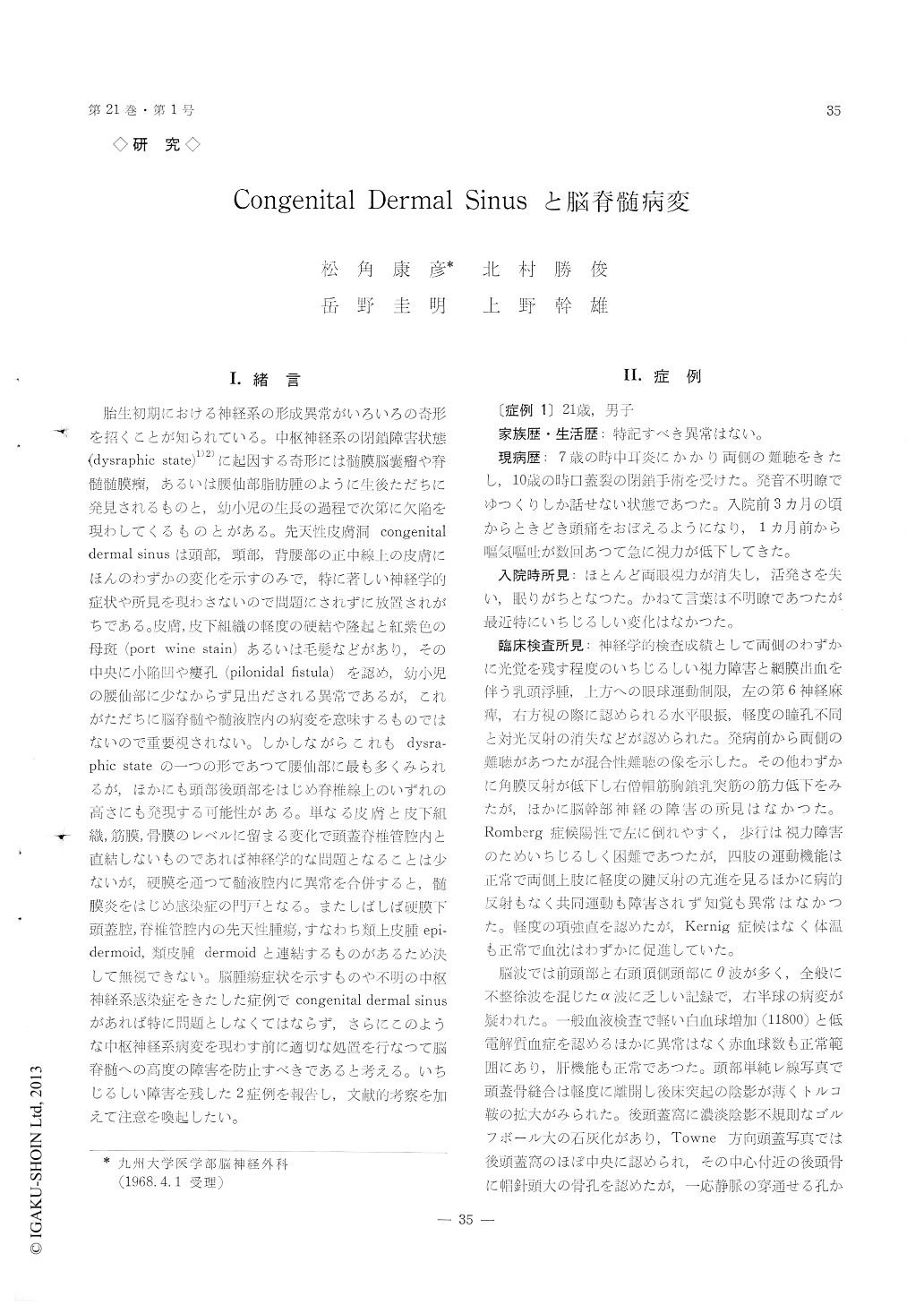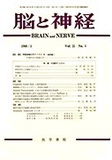Japanese
English
- 有料閲覧
- Abstract 文献概要
- 1ページ目 Look Inside
I.緒言
胎生初期における神経系の形成異常がいろいろの奇形を招くことが知られている。中枢神経系の閉鎖障害状態(dysraphic state1)2))に起因する奇形には髄膜脳嚢瘤や脊髄髄膜瘤,あるいは腰仙部脂肪腫のように生後ただちに発見されるものと,幼小児の生長の過程で次第に欠陥を現わしてくるものとがある。先天性皮膚洞congenital dermal sinusは頭部,頸部,背腰部の正中線上の皮膚にほんのわずかの変化を示すのみで,特に著しい神経学的症状や所見を現わさないので問題にされずに放置されがちである。皮膚,皮下組織の軽度の硬結や隆起と紅紫色の母斑(port wine stain)あるいは毛髪などがあり,その中央に小陥凹や瘻孔(pilonidal fistula)を認め,幼小児の腰仙部に少なからず見出だされる異常であるが,これがただちに脳脊髄や髄液腔内の病変を意味するものではないので重要視されない。しかしながらこれもdysra—phic stateの一つの形であって腰仙部に最も多くみられるが,ほかにも頭部後頭祁をはじめ脊椎線上のいずれの高さにも発現する可能性がある。単なる皮膚と皮下組織,筋膜,骨膜のレベルに留まる変化で頭蓋脊椎管腔内と直結しないものであれば神経学的な問題となることは少ないが,硬膜を通つて髄液腔内に異常を合併すると,髄膜炎をはじめ感染症の門戸となる。またしばしば硬膜下頭蓋腔,脊椎管腔内の先天性腫瘍,すなわち類上皮腫epi—dermoid,類皮腫dermoidと連結するものがあるため決して無視できない。脳腫瘍症状を示すものや不明の中枢神経系感染症をきたした症例でcongenital dermal sinusがあれば特に問題としなくてはならず,さらにこのような中枢神経系病変を現わす前に適切な処置を行なって脳脊髄への高度の障害を防止すべきであると考える。いちじるしい障害を残した2症例を報告し,文献的与察を加えて注意を喚起したい。
Two cases of congenital dermal sinus associated with intracranial or -spinal complications were report-ed. A dermoid was found in the posterior fossa of a 20-year-old man, who developed an acutely in-creased intracranial pressure and subsequent loss of vision. In the other 14-month-old girl recurrent febrile episodes were followed by E. coli infection of intraspinal epidermoid and dorso-lumbar subara-chnoid abscess. Both were noted to have congenital dermal sinus or fistula, one was below the Inionand the other in the sacro-coccygeal region, and they had been neglected equally until severe neurological complications developed.
Emphasis was placed on proper management of the dermal sinus in the early lifetime in order to prevent neurological disabilities, and particular in-terst was concerned to detect which dermal sinus should possibly communicate to the craniospinal cavity. Analysis of previously reported cases was made and the following conclusion was obtained. Congenital dermal sinuses accompanying cranio-spinal bony abnormalities, such as a small hole of the skull, spina bifida occulta or defect of the spinous process under the dermal sinus entailed the possibility of intracranial or -spinal complications. Among those complications congenital tumors (epider-moid, dermoid and teratoma) were reported most frequently, and infection of the central nervous system from the dermal sinus or fistula was the other possibility.
It is most important to X-ray the skull or spine and excision of the sinus should be made when radiographical abnormality, especially in the higher level of the spine, or discharge from the sinus are encountered, and if the sinus is connected to the dura the possibility of intracranial or -spinal com-plication is exceedingly high.
Infection of the central nervous system through intradurally communicating dermal sinus or fistula should be kept in mind while children with multiple unknown febrile episodes are being examined.

Copyright © 1969, Igaku-Shoin Ltd. All rights reserved.


